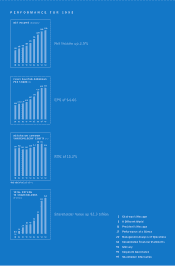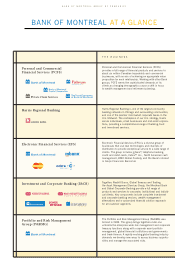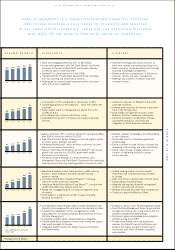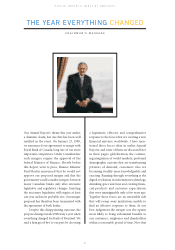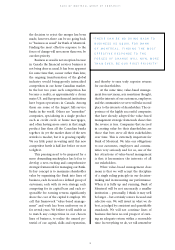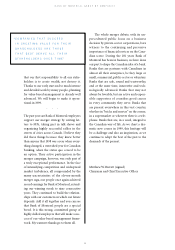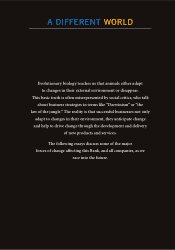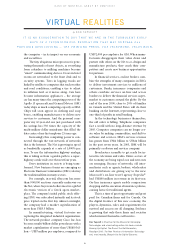Bank of Montreal 1998 Annual Report Download - page 10
Download and view the complete annual report
Please find page 10 of the 1998 Bank of Montreal annual report below. You can navigate through the pages in the report by either clicking on the pages listed below, or by using the keyword search tool below to find specific information within the annual report.
6
BANK OF MONTREAL GROUP OF COMPANIES
the computer – in its impact on our economic
and social lives.
The tiny, ubiquitous microprocessor is pene-
trating
thousands of inert objects, as everything
from calendars to milking machines become
“smart” communicating devices. Doors in hotel
rooms are networked to the front desk and to
security systems. Tires in logging trucks are
linked by satellite to computers that track weather
and road conditions, enabling a tire to adjust
its inflation level as it moves along. Cars have
become information appliances – the average
car has many times the computing power of the
Apollo 13 spacecraft, and General Motors (GM)
today
ships as much computing capacity as IBM.
Chips
will soon appear in clothing and soap
boxes, enabling manufacturers to deliver new
services to customers. And the personal com-
puter my 12-year-old son just purchased with
his savings has 750 times the capacity of the
multi-million-dollar mainframe that filled the
data centre of my first employer 25 years ago.
Increasingly this computing power is con-
nected through the vast network of networks
that is the Internet. The Net is growing in speed
as bandwidth expands at a rate of 1,000% per
year. To use the information highway analogy,
this is taking us from a garden path to a super-
highway a mile wide over the next four years.
Every institution in society is being trans-
formed. New business forms are emerging as
Electronic Business Communities (EBCs) destroy
the traditional firm in many sectors.
For example, in retail, eBay.com has more
than 900,000 auctions currently underway on
the Net, where buyers and sellers meet in a global
electronic version of a Greek agora market-
place. The company’s initial public stock offer-
ing (IPO) was subscribed instantly and its stock
price tripled on the first day. Almost overnight,
the company had a market capitalization of
more than US$3.3 billion.
In manufacturing, virtual factories are
replacing the integrated industrial organization.
The network product company Cisco Inc. has
become a multi-billion-dollar powerhouse with a
market capitalization of more than US$100 bil-
lion – US$7 million per employee, compared to
US$72,000 per employee for GM. When manu-
facturers disaggregate their value chain and
partner with others on the Net to co-design and
manufacture products, they crush their com-
petitors and create new business opportunities
for partners.
In financial services, on-line brokers com-
bine the strengths of many companies in EBCs
to deliver investment services to millions of
customers. Banks, insurance companies and
others combine services on-line and across
borders to deliver the financial services super-
market to customers around the globe. By the
end of the year 2000, close to 20% of families
in Canada and the United States will do their
banking on the Internet, representing close to
one-third of profits in retail banking.
In the technology businesses themselves,
the old order is falling. Telephone companies
face a world with no long-distance revenue by
2005. Computer companies can no longer cre-
ate value by making commodities, and shift to
software and services. IBM’s services revenue
has grown from US$2 billion to US$24 billion
in the past seven years. In 2005, IBM will be
primarily a software and services company.
Broadcasters scramble to get ready for in-
teractive television and radio. Entire sectors of
the economy are being wiped out, and new ones
are emerging. Because of networks, old inter-
mediaries such as agents, brokers, wholesalers
and distributors are giving way to the new.
Microsoft’s on-line travel agency Expedia®
3
had US$100 million in revenue in its first year.
On-line insurance agents enable comparison
shopping and the execution of insurance policies,
causing havoc for traditional agents.
This is a time of great opportunity and great
peril for Canadian firms and for Canada. On
the digital frontier of this new economy, the
players, dynamics, rules and requirements for
survival and success are all changing. Evidence
is growing that only those firms and societies
which reinvent themselves will survive.
Don Tapscott is Chairman for the Alliance for Converging
Technologies and a best-selling author. His books include
Growing Up Digital: The Rise of the Net Generation,
Paradigm Shift: The New Promise of Information Technology
and, most recently, Blueprint to the Digital Economy.
VIRTUAL REALITIES
by DON TAPSCOTT
IT IS NO EXAGGERATION TO SAY THAT WE ARE IN THE TURBULENT EARLY
DAYS OF A TECHNOLOGICAL REVOLUTION THAT MAY SURPASS ALL
PREVIOUS REVOLUTIONS
–
THE PRINTING PRESS, THE TELEPHONE, TELEVISION,


